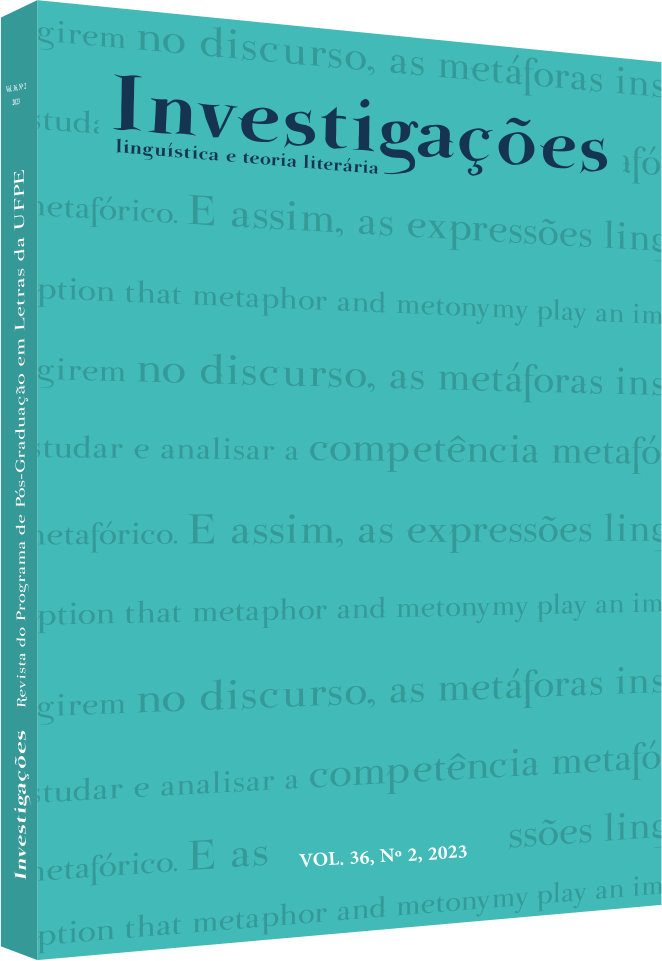The use of colour in the comic O despertar de Cthulhu: a multimodal analysis
DOI:
https://doi.org/10.51359/2175-294x.2023.259598Keywords:
multimodality, comics, colors, Grammar of Visual DesignAbstract
This article aims to analyse how the color is used to construct meanings in the comic O despertar de Cthulhu. To support the discussion, we start from multimodality (KRESS; VAN LEEUWEN, 2006; KRESS, 2010). The corpus consists of three stories of the comic. For the analysis, the categories of modality, from the interactive metafunction, and salience, from the compositional metafunction, were chosen. Based on these categories, we observe that the green, in the three stories, builds a representation of the supernatural/evil, which builds a sense of unity, in addition to the colors taking on the function of interacting with the reader and conducting the narrative.
References
ARAÚJO, C.; CASTRO, M. de. Sob a insana luz: In: FERNANDES, R. (org.). O despertar de Cthulhu. São Paulo: Draco, 2016. p. 65-84.
BURNS, C. Black hole. Tradução: Daniel Pellizzari. Rio de Janeiro: Darkside Books, 2017.
BBC News Brasil, 2023. Instagram. Disponível em: https://www.instagram.com/bbcbrasil/?hl=pt-br. Acesso em: 14 abr. 2024.
CHIARELLO, M. The DC Comics guide to coloring and lettering comics. Nova Iorque: Watson-Guptill publications, 2004.
CIRLOT, J. E. Diccionario de símbolos. Editorial Labor: Barcelona, 1992.
DEPÓSITO de tirinhas, 2024. Instagram. Disponível em: https://www.instagram.com/depositodetirinhas/. Acesso em: 14 abr. 2024.
FREEP!K, [2024]. Disponível em: https://br.freepik.com/. Acesso em: 14 abr. 2024.
FORESTI, G. Blog Algo Disponível, 25 mar. 2010. Disponível em: https://algodisponivel.wordpress.com/tag/turma-da-monica/. Acesso em: 26 abr. 2024.
GARCIA, B.; AQUINO, E. O que dorme. In: FERNANDES, R (org.). O despertar de Cthulhu. São Paulo: Draco, 2016. p. 145-164.
JEWITT, C. Different approaches to multimodality. In: JEWITT, C. The routledge handbook of multimodal analysis. London; New York: Routledge, 2009. p. 28-39.
KRESS, G. Multimodality: a social semiotic approach to contemporary communication. Canada; New York: Routledge, 2010.
KRESS, G.; VAN LEEUWEN, T. Reading images: the grammar of visual design. 2. ed. London; New York: Routledge, 2006.
O BEBÊ de Rosemary. Grupo estação, [s.l.], [2017]. Disponível em: http://www.grupoestacao.com.br/site/index.php?option=com_k2&view=item&id=2545&lang=pt. Acesso em: 20 ago. 2023.
OITO artistas hiper-realistas que você deveria conhecer. Domestika, 2021. Disponível em: https://www.domestika.org/pt/blog/4012-8-artistas-hiper-realistas-que-voce-deveria-conhecer. Acesso em: 14 abr. 2024.
RAMOS, P. E. Tiras cômicas e piadas: duas leituras, um efeito de humor. 2007. Tese (Doutorado em Filologia e Língua Portuguesa) – Faculdade de Filosofia, Letras e Ciências Humanas, Universidade de São Paulo, São Paulo, 2007. Disponível em: https://www.teses.usp.br/teses/disponiveis/8/8142/tde-04092007-141941/pt-br.php. Acesso em: 18 maio. 2023.
SAUSSURE, F. Curso de Linguística Geral. Organizado por Charles Bally e Albert Sechehaye. São Paulo: Editora Cultrix, 2006.
TORRES, D. O salmo do sangue antigo. In: FERNANDES, R (org.). O despertar de Cthulhu. São Paulo: Draco, 2016. p. 5-24.
VER capas, [2024]. Disponível em: https://www.vercapas.com.br/. Acesso em: 14 abr. 2024.
YUGE, C. Batman finalmente explica por que rejeita ter superpoderes em nova HQ. Terra, 17 abr. 2023. Disponível em: https://www.terra.com.br/byte/batman-finalmente-explica-por-que-rejeita-ter-superpoderes-em-nova-hq,4fd16187ea48a5d802d11c8c32a4b397pyf085g3.html. Acesso em: 20 ago. 2023.
ZOCCHI, G. As maldições dos sets de gravação dos filmes de terror. Capricho, São Paulo, 31 out. 2018. Disponível em: https://capricho.abril.com.br/entretenimento/as-maldicoes-dos-sets-de-filmagem-de-filmes-de-terror. Acesso em: 15 jul. 2023.
Downloads
Published
How to Cite
Issue
Section
License
Copyright (c) 2024 Estela Carielli de Castro

This work is licensed under a Creative Commons Attribution 4.0 International License.
Authors who publish with Revista Investigações agree to the following terms:
Authors retain copyright and grant the journal right of first publication with the work simultaneously licensed under the Creative Commons Attribution 4.0 International (CC BY 4.0) license that allows others to share the work with an acknowledgement of the work's authorship and initial publication in this journal.
Authors are able to enter into separate, additional contractual arrangements for the non-exclusive distribution of the journal's published version of the work (e.g., post it to an institutional repository or publish it in a book), with an acknowledgement of its initial publication in this journal.
You are free to:
Share — copy and redistribute the material in any medium or format for any purpose, even commercially.
Adapt — remix, transform, and build upon the material for any purpose, even commercially.
The licensor cannot revoke these freedoms as long as you follow the license terms.
Under the following terms:
Attribution — You must give appropriate credit , provide a link to the license, and indicate if changes were made . You may do so in any reasonable manner, but not in any way that suggests the licensor endorses you or your use.
No additional restrictions — You may not apply legal terms or technological measures that legally restrict others from doing anything the license permits.

